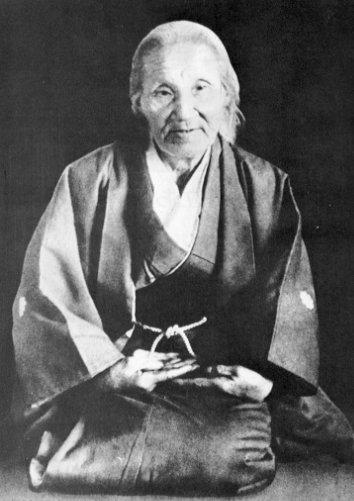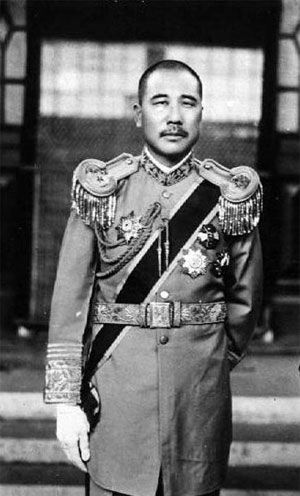|
Kohinata Hakurō
Kohinata Hakurō (, Hiragana: こひなた はくろう; January 31, 1900 - January 5, 1982), born Kohinata Takematsu (Chinese pseudonyms include Xiang Lang, Shang Xudong, and Shao Rixiang), courtesy name Senzan Koji, was a notorious Japanese mounted bandit in China. He was commonly called "The Little White Dragon" by Chinese locals of the areas he was active in. Life Early life Kohinata Hakurō was born in Sanjō, Niigata Prefecture. Early in his life, he admired general Fukushima Yasumasa, who in 1892 rode on horseback by himself from Berlin to Vladivostok, crossing two continents. At the age of 17, Kohinata had the choice to go to China, Tibet, and Germany for an investigation, so he chose to go to China. He joined the Gen'yousha (Dark Ocean Society) led by nationalist Toyama Mitsuru.Honeck, Mischa and Marten, James''War and Childhood in the Era of the Two World Wars'' Cambridge University Press, 2-21-2019. p. 63. During his time in China, he was thought highly of by Banz ... [...More Info...] [...Related Items...] OR: [Wikipedia] [Google] [Baidu] |
Sanjō, Niigata
is a Cities of Japan, city located in Niigata Prefecture, Japan. , the city had an estimated population of 95,706 in 36,201 households, and a population density of 222 persons per km². The total area of the city was . Geography Sanjō is located in an inland region of north-central Niigata Prefecture. It is about 2 hours from Tokyo via the Jōetsu Shinkansen or 4 hours on the Kan-Etsu Expressway and Hokuriku Expressway. The Shinano River flows through the west of it from south to north and the Ikarashi-gawa River flows through the centre of the urbanised area. Surrounding municipalities *Fukushima Prefecture ** Tadami, Fukushima, Tadami *Niigata Prefecture ** Aga, Niigata, Aga ** Gosen, Niigata, Gosen ** Kamo, Niigata, Kamo ** Mitsuke, Niigata, Mitsuke ** Nagaoka, Niigata, Nagaoka ** Niigata, Niigata, Niigata ** Tsubame, Niigata, Tsubame ** Uonuma, Niigata, Uonuma Climate Sanjō has a Humid subtropical climate, Humid climate (Köppen ''Cfa'') characterized by warm, wet summers ... [...More Info...] [...Related Items...] OR: [Wikipedia] [Google] [Baidu] |
Mounted Bandits
A mounted bandit (, ) is a bandit who uses horseback for mobility. The term is particularly used for mounted bandits who were active in Manchuria and its surrounding region from the end of the Qing Dynasty to the Manchukuo period. History Despite their strong association with banditry, the mounted bandits originated with guerrilla activities by vigilante self-defence organisations. With the decline of the Qing Dynasty, public safety worsened, and Manchuria became infested with thieves. The locals formed self-defence organisations to counter this. But after the 1911 Revolution, as the chaos in Manchuria intensified, the more powerful vigilantes went beyond their original goal of self-defence and began acting as bandits themselves. The mounted bandits valued horsemanship and sharpshooting skills. Members of the same gang generally belonged to the same clan or ancestral home, although they were sometimes joined by foreigners such as Koreans, White Russians, and Japanese continent ... [...More Info...] [...Related Items...] OR: [Wikipedia] [Google] [Baidu] |
Morihei Ueshiba
was a Japanese martial artist and founder of the Japanese martial art, martial art of aikido. He is often referred to as "the founder" or , "Great Teacher". The son of a landowner from Tanabe, Wakayama, Tanabe, Ueshiba studied a number of martial arts in his youth, and served in the Imperial Japanese Army, Japanese Army during the Russo-Japanese War. After being discharged in 1907, he moved to Hokkaido as the head of a pioneer settlement; here he met and studied with Takeda Sōkaku, the headmaster of Daitō-ryū Aiki-jūjutsu. On leaving Hokkaido in 1919, Ueshiba joined the Ōmoto-kyō movement, a Shinto sect, in Ayabe, Kyoto, Ayabe, where he served as a martial arts instructor and opened his first dojo. He accompanied the head of the Ōmoto-kyō group, Onisaburo Deguchi, on an expedition to Mongolia in 1924, where they were captured by Chinese troops and returned to Japan. The following year, he had a profound spiritual experience, stating that, "a golden spirit sprang up f ... [...More Info...] [...Related Items...] OR: [Wikipedia] [Google] [Baidu] |
Onisaburo Deguchi
, born Kisaburō Ueda 上田 喜三郎 (1871–1948) was a Japanese religious leader. Together with his mother-in-law Nao Deguchi, he was one of the two spiritual leaders of the Oomoto religious movement in Japan. While Nao Deguchi is the of Oomoto, Onisaburo Deguchi is the . Biography Onisaburo had studied Honda Chikaatsu's ''Spirit Studies'' (''Honda Reigaku'') and also learned to mediate spirit possession ('' chinkon kishin'' 鎮魂帰神) from Honda's disciple in Shimizu, Shizuoka. Starting from March 1, 1898, he followed a hermit named Matsuoka Fuyō (松岡芙蓉), who was a messenger of the kami Kono-hana-saku-ya-hime-no-mikoto (木花咲耶姫命), to a cave on Mount Takakuma near Kameoka, Kyoto, where Onisaburo performed intense ascetic training for one week. While enduring cold weather with only a cotton robe, as well as hunger and thirst, Onisaburo received divine revelations and claimed to have traveled into the spirit world. Onisaburo met the founder of Omot ... [...More Info...] [...Related Items...] OR: [Wikipedia] [Google] [Baidu] |
Ōmoto
200px, ''Chōseiden'' (長生殿) in Ayabe , also known as , is a religion founded in the 1890s by Deguchi Nao (1836–1918) and Deguchi Onisaburō (1871–1948). Oomoto is typically categorized as a Shinto-based Japanese new religion. The spiritual leaders of the movement have always been women within the Deguchi family, along with Onisaburō as its founding '' seishi'' (spiritual teacher). Since 2001, the movement has been guided by its fifth leader, Kurenai Deguchi. Oomoto's administrative headquarters is in Kameoka, Kyoto (Onisaburo Deguchi's hometown), and its spiritual headquarters is in Ayabe, Kyoto (Nao Deguchi's hometown). Uniquely among Japanese religions, Oomoto makes extensive use of the constructed language Esperanto in order promote itself as a world religion. Oomoto has historically engaged in extensive interfaith dialogue with religions such as the Baháʼí Faith, Christianity, and Islam, since a key tenet of Oomoto is that all religions come from the same ... [...More Info...] [...Related Items...] OR: [Wikipedia] [Google] [Baidu] |
Second Zhili-Fengtian War
The second (symbol: s) is a unit of time derived from the division of the day first into 24 hours, then to 60 minutes, and finally to 60 seconds each (24 × 60 × 60 = 86400). The current and formal definition in the International System of Units (SI) is more precise: The second ..is defined by taking the fixed numerical value of the caesium frequency, Δ''ν''Cs, the unperturbed ground-state hyperfine transition frequency of the caesium 133 atom, to be when expressed in the unit Hz, which is equal to s−1. This current definition was adopted in 1967 when it became feasible to define the second based on fundamental properties of nature with caesium clocks. As the speed of Earth's rotation varies and is slowing ever so slightly, a leap second is added at irregular intervals to civil time to keep clocks in sync with Earth's rotation. The definition that is based on of a rotation of the earth is still used by the Universal Time 1 (UT1) system. Etymology "Minute" co ... [...More Info...] [...Related Items...] OR: [Wikipedia] [Google] [Baidu] |
Zhang Zuolin
Zhang Zuolin; courtesy name Yuting ( zh, c=雨亭, p=Yǔtíng, labels=no) and nicknamed Zhang Laogang ( zh, c=張老疙瘩, p=Zhāng Lǎo Gēda, labels=no) (March 19, 1875June 4, 1928) was a Chinese warlord who ruled Manchuria from 1916 to 1928 and led the Fengtian clique, one of the most powerful factions during the Warlord Era. In 1927, he became the leader of the Beiyang government and was declared Generalissimo of the Republic of China. Born to a poor peasant's family in Manchuria, Zhang became a prominent bandit in the region in the 1890s. After the Boxer Rebellion, his troops became a regiment of the Qing dynasty's army, and during the Russo-Japanese War, they were hired by the Japanese Army as mercenaries. During the 1911 Revolution, Zhang initially fought against the revolutionaries, and after the foundation of the Republic of China supported the Beiyang government. Zhang founded the Fengtian clique and gradually expanded his Northeastern Army, which established his ... [...More Info...] [...Related Items...] OR: [Wikipedia] [Google] [Baidu] |
Fengtian Clique
The Fengtian clique () was the faction that supported warlord Zhang Zuolin during Republic of China (1912–1949), China's Warlord Era. It took its name from Fengtian Province, which served as its original base of support. However, the clique quickly came to control all of the Viceroy of the Three Northeast Provinces, Three Northeastern Provinces. The clique received support from Empire of Japan, Japan in exchange for protecting Japanese military and economic interests in Manchuria. The Northeastern Army, Fengtian Army frequently intervened in many of the conflicts of the Warlord Era. Following the Zhili–Anhui War of 1920 and 1921, the Fengtian and Zhili cliques exercised joint control of Beijing and the Beiyang Government. Tensions soon began building between the two, resulting in clashes for control of Beijing known as the First Zhili–Fengtian War, First Zhili–Fengtian War (1922). The Second Zhili–Fengtian War, Second (1924) Zhili–Fengtian War started later over the Zhi ... [...More Info...] [...Related Items...] OR: [Wikipedia] [Google] [Baidu] |
Zhang Zongchang
Zhang Zongchang (; also romanized as Chang Tsung-chang; 1881 – 3 September 1932), courtesy name Xiaokun, was a Chinese warlord who ruled Shandong from 1925 to 1928. A member of the Fengtian clique, Zhang was notorious for his brutal and ruthless behavior, eccentric personality, and extravagant lifestyle, which earned him nicknames such as the "Dogmeat General"; ''Time'' dubbed him China's "basest warlord". Zhang's troops were defeated by the National Revolutionary Army during the Northern Expedition in 1928, and he fled to Japan before returning to Shandong in 1932, where he was assassinated by a young officer. Biography Early life and career Zhang was born in 1881 in Yi County (now Laizhou) in Shandong. His family was poor. Zhang's father worked as a head shaver and trumpeter, and was an alcoholic. His mother was an exorcist and "practicing witch". His parents eventually separated. Zhang stayed with his mother who had taken a new lover. In his teens, Zhang's family mov ... [...More Info...] [...Related Items...] OR: [Wikipedia] [Google] [Baidu] |
John Browning
John Moses Browning (January 23, 1855 – November 26, 1926) was an American firearm designer who developed many varieties of military and civilian firearms, cartridges, and gun mechanisms, many of which are still in use around the world. He made his first firearm at age 13 in his father's gun shop and was awarded the first of his 128 firearm patents on October 7, 1879, at the age of 24. He is regarded as one of the most successful firearms designers of the 19th and 20th centuries and a pioneer of modern repeating, semi-automatic, and automatic firearms. Browning influenced nearly all categories of firearms design, especially the autoloading of ammunition. He invented, or made significant improvements to, single-shot, lever-action, and pump-action rifles and shotguns. He developed the first reliable and compact autoloading pistols by inventing the telescoping bolt, then integrating the bolt and barrel shroud into what is known as the pistol slide. Browning's telescoping b ... [...More Info...] [...Related Items...] OR: [Wikipedia] [Google] [Baidu] |








